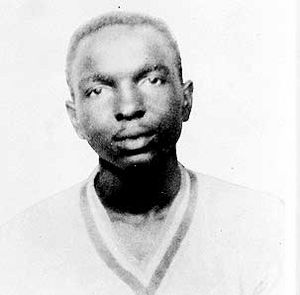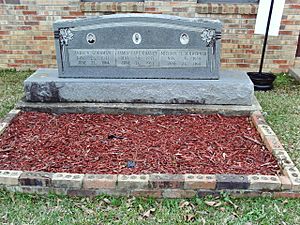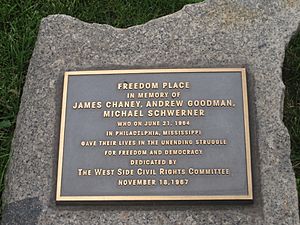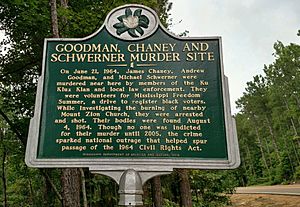James Chaney facts for kids
Quick facts for kids
James Chaney
|
|
|---|---|
 |
|
| Born |
James Earl Chaney
May 30, 1943 |
| Died | June 21, 1964 (aged 21) |
| Cause of death | Murder |
| Awards | Presidential Medal of Freedom (Posthumous; 2014) |
James Earl Chaney (born May 30, 1943 – died June 21, 1964) was a brave young man who worked for civil rights. He was one of three civil rights workers killed in Philadelphia, Mississippi. This happened on June 21, 1964, by members of the Ku Klux Klan. The other two workers were Andrew Goodman and Michael Schwerner. They were all working to help African Americans gain equal rights.
Contents
Biography
Early Life and Education
James Chaney was the oldest son of Fannie Lee and Ben Chaney, Sr. He had a younger brother, Ben, and three sisters: Barbara, Janice, and Julia. James went to Catholic school for his first nine grades. He was also a member of St. Joseph Catholic Church.
When James was 15, he was a high school student. He and some friends wore paper badges that said "NAACP". This showed their support for the NAACP, a group working for civil rights. The principal of their school suspended them for a week. This was because the school was segregated (meaning Black and white students went to separate schools). The principal worried about what the all-white school board would do.
After high school, James became an apprentice plasterer. This meant he was learning a trade in a union.
Working for Civil Rights
In 1962, James Chaney took part in a "Freedom Ride". This was a protest where people rode buses together to challenge segregation. He rode from Tennessee to Greenville, Mississippi, and then to Meridian. He and his younger brother also joined other peaceful protests.
James started volunteering with the Congress of Racial Equality (CORE) in late 1963. He then joined CORE in Meridian. He helped teach people about voting. He also introduced CORE workers to local church leaders. He helped CORE workers travel around different counties.
In 1964, James met with leaders of the Mt. Nebo Baptist Church. He wanted them to let Michael Schwerner, a CORE leader, speak to their church members. Michael wanted to encourage people to use the church for voter education and registration. James also helped other CORE members connect with each other.
His Murder

In June 1964, James Chaney and his fellow civil rights workers, Michael Schwerner and Andrew Goodman, were killed. This happened near Philadelphia, Mississippi. They were looking into the burning of Mt. Zion Methodist Church. This church had been used as a place for a CORE Freedom School.
Before this, members of the Ku Klux Klan had beaten churchgoers. This happened after Schwerner and Chaney held voter registration rallies. People said that the sheriff's deputy, Cecil Price, stopped their cars. He made church leaders kneel in their car headlights while white men beat them. The same Klan members who beat them were also said to have burned the church.
Deputy Price arrested Chaney, Goodman, and Schwerner. He said they had a traffic violation. He took them to the Neshoba County jail. They were let go that evening, but they could not call anyone. On their way back to Meridian, they were stopped again. This time, it was by patrol lights and two cars full of Ku Klux Klan members. This happened on Highway 19.
The men were then taken in Price's car to a remote road. The Klan members shot and killed Schwerner, then Goodman. They shot Chaney three times after beating him badly. The young men were buried in a nearby earthen dam.
Their bodies were not found for 44 days. The FBI joined the case. This was a major national story. It happened during a time when many civil rights workers were helping people register to vote in Mississippi.
Rita Schwerner, Michael's widow, also worked for CORE. She was upset that the news had not paid attention to other murders of Black people. She felt that this case got attention because two white men from New York were missing. She believed that if only Chaney, a Black man, had been missing, the case would not have gotten as much notice.
After the Murder
After James's funeral, his family left Mississippi. They had received death threats. The families of Goodman and Schwerner, and other supporters, helped them. They moved to New York City. James's younger brother, Ben, went to a private high school there.
Ben Chaney later founded the James Earl Chaney Foundation. He did this to honor his brother. The foundation works to promote civil rights and social justice.
Legal Actions
Federal Trial
In 1967, the U.S. government put ten men on trial. They were charged with conspiring to take away the civil rights of the three murdered men. This was under a federal law called the Enforcement Act of 1870. The jury found seven men guilty, including Deputy Sheriff Price. Three men were found not guilty. One of them was Edgar Ray Killen, a former Ku Klux Klan organizer. He had planned and directed the murders.
State Investigation

For many years, people asked the state to charge the murderers. A journalist named Jerry Mitchell found new evidence. He wrote many articles about the case. Mitchell had helped solve other Civil Rights Era murder cases. He found new witnesses and pushed the state to investigate. The state started a new investigation in the early 2000s.

In 2004, a high school teacher named Barry Bradford and three of his students joined Mitchell's efforts. They did more research and made a documentary. Their documentary showed important new evidence. It gave strong reasons to reopen the case. They even got a taped interview with Edgar Ray Killen. Killen had been found not guilty in the first trial. He was a known white supremacist and was called the "Preacher." This interview helped convince the state to reopen the investigation.
In 2005, the state charged Killen with the murders. He was the only one of six living suspects to be charged. Killen pleaded "Not guilty" when his trial began on January 7, 2005. Evidence showed that he had overseen the murders. The jury found him guilty of three counts of manslaughter on June 20, 2005. Manslaughter means causing someone's death without planning it beforehand. He was sentenced to 60 years in prison. This was 20 years for each count, served one after another.
Ben Chaney believes other men were involved in his brother's death. He thinks they should also be charged. He has said, "I'm not as sad as I was. But I'm still angry."
Legacy and Honors
- In 1998, Ben Chaney started the James Earl Chaney Foundation. It honors his older brother. The foundation works to promote civil rights and social justice.
- James Chaney, along with Goodman and Schwerner, received a special award. It was the Presidential Medal of Freedom. President Barack Obama gave it to them in 2014, after their deaths.
See also
 In Spanish: James Chaney para niños
In Spanish: James Chaney para niños


